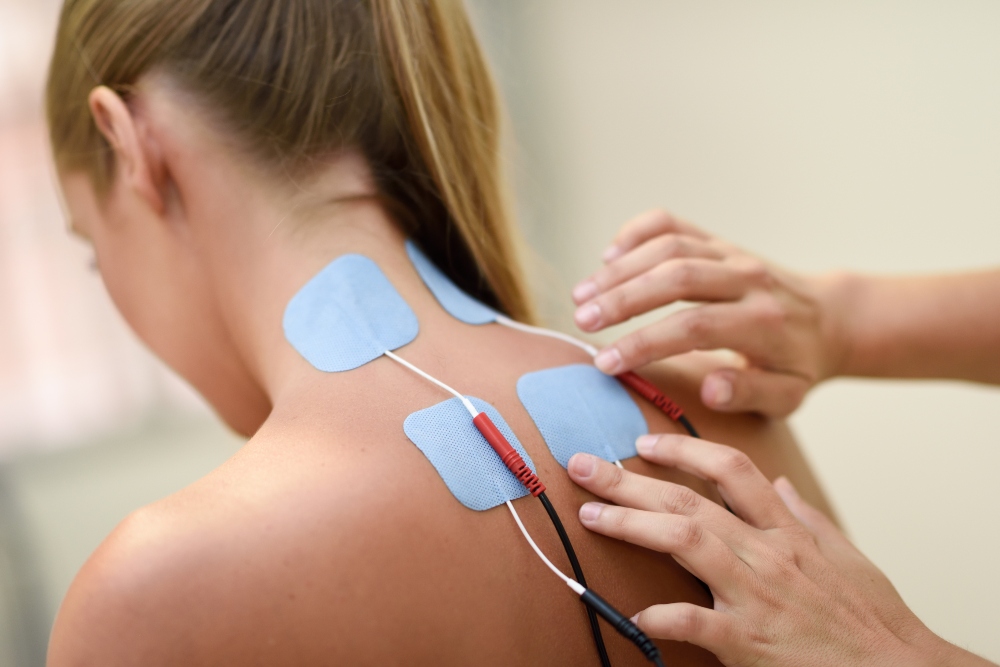
Electro stimulation in physical therapy to a young woman. Medical check at the shoulder in a physiotherapy center.
Joint pain can be part of an old injury, an active sporting injury, or simply genetic. The important thing to determine is the figure out the source of the pain. Do you have arthritis? If so, what type? Working with a physical therapist is the best way to have your movements monitored, get corrections made to your movements, and reduce the strain on your joints.
1) Monitoring
Our joints are always under stress. The mechanics of moving our long bones effectively actually at the pivot point or joint can lead to a lot of variables. Your physical therapist can monitor your movements, note any failures or glitches in your range of motion, and help you to move more smoothly.
The monitoring progress may seem a little dull. It can also be nit-picky. However, a small adjustment in the movement of your elbow can cause a change in your grip and may lead to pain in your wrist. It can also cause wear and tear in your fingers if your grip is weakened by damage in the shoulder.
2) Following the Connections
A little pain in your hip can shorten your stride, which can impact your knees, which may impact your ankles, which can weaken your feet. If you play any sports, a physical therapist will know that you work out, play, and exercise when you’re hurt. At Headquarters PT, a company that does physical therapy in Portland, Oregon, they promote science-based information about what it is the client is trying to accomplish, what actually works best for their injuries, and how to make sense of other information that they’ve been told regarding their pain.
Monitoring the connections of the original pain can help you to address the original pain, adjust your movement, and increase your strength to help you move away from repetitive motions that don’t create joint damage.
3) Wear and Tear
If your joints have already taken a beating, you may be facing wear and tear arthritis, or osteoarthritis. A physical therapist can help you to build strength without putting a great deal of pressure on damaged joints.
Your fitness goals are a bit further away once you develop arthritis. However, you can learn
- excellent posture
- terrific alignment
- proper mechanics
with the help of a physical therapist who can monitor your movements for poor mechanics.
4) Basic Activities
If your joint pain has made it hard to do ordinary activities, discuss your challenge with your PT professional. For example, you may be able go to the gym every day, get in the water, and stretch out stiff joints. You feel great after this workout, but you avoid going to the grocery store because it’s terribly hard to get in and out of your car.
Invite your physical therapist out to your car. Show them your struggles. Work out a proper way to get out of your car that doesn’t hurt, and once you’ve got that mastered, work with your physical therapist to build a routine to strengthen the muscles needed to get out of your car without using your hands. Turn your problem into a new workout by increasing your strength.
5) Rinse and Repeat
As you get stronger, it may be tempting to move onto new exercises and skip the baby steps you worked out with your therapist. This is a mistake. Your therapist developed exercises to help you build good mechanics. Use those basic exercises as your warm-up. Everything you do, as a human and as an athlete, is tied to mechanics. Poor body mechanics will ultimately cause pain.
In addition to pain, poor body mechanics can cause weakness, particularly in the paired muscle. If your knee joint hurts, you may change your gait to shorten the length of time you support your body on that knee. Over time, this can cause weakness in the leg with the sore knee. Once one leg is weaker than the other, you may be at risk for a low back injury. If your joints hurt, get help before your body adapts and leads you toward much bigger injuries and problems.
Your physical therapist isn’t there to turn you into an Olympian. However, with a skilled therapist who can observe your movements, you will be made aware of what actions are putting the wrong type of pressure on the joint. Once you correct that action and rebuild the muscular strength to use the joint as efficiently and effectively as possible, you have a better chance of avoiding joint pain.


